Posted by Anita on 12.19.10 3:24 PM
 Hungry Mother always seemed like the kind of place we’d enjoy: local and sustainable sourcing, Southern-inspired food, and a great cocktail list. It’s been on our short list of places to try for years, and on a recent trip to Boston, we finally made it there.
Hungry Mother always seemed like the kind of place we’d enjoy: local and sustainable sourcing, Southern-inspired food, and a great cocktail list. It’s been on our short list of places to try for years, and on a recent trip to Boston, we finally made it there.
It’s easy to win hearts and minds with menu items like pimento cheese, bourbon-braised pork shoulder, and cheddar grits with house-made tasso, not to mention winning cocktails like the No. 43 (rye, tawny port, maple syrup, and bitters). But amid all of these decadent treats was a salad that sounded so tame that I actually felt a little boring for ordering it.
The buttermilk-chive dressing was what pushed me over the edge, luring me away from other options. That, I suppose, and the pecans, which I love but can’t get locally here in Northern California. What I hadn’t expected was that the farro — a humble, wheat-like grain — would be the star of the show, bringing a nutty depth to the dish that made it substantial enough to stand up to the rich main courses that followed.
I woke up the next morning dreaming about this salad, knowing I wanted to recreate it when we got home. I realized that with a few adjustments — walnuts for pecans, wheatberries for farro — I could make it entirely from locally sourced ingredients, making it a perfect candidate for our first Dark Days Eat Local Challenge meal of the winter.
Don’t be put off by the little ingredient-prep recipes that go into this dish; none are particularly difficult or time-consuming, and all of the parts can be stored for future use. And be sure that you’re picking through and using tender frisée leaves, as more-mature ones are unpleasantly grassy and spiky.


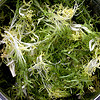

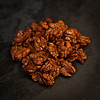
Autumn Salad with Wheatberries
– inspired by Hungry Mother; serves 2
6 cups loosely packed tender frisée leaves
3 to 4T buttermilk dressing
1/2 cup cooked wheatberries
roasted beet wedges equal to 1 large beet (or 2 to 3 small beets)
1 watermelon radish (or 3 to 5 small radishes), sliced thinly and cut into quarter-rounds
6 to 8 sweet-savory walnut halves
Toss all ingredients together, and serve on chilled shallow bowls or rimmed plates.
– Roasted Beets
Preheat the oven to 375°F. Scrub the beets and trim off tops and tails. Place in a baking dish about as deep as the beets are tall, and add 1/4 inch of water. Cover tightly with foil and bake until the beets are barely tender through (run a toothpick or cake tester through the center), about 45 minutes for large beets, 20 to 30 minutes for smaller ones. Remove from the oven and let sit, covered, for 5 more minutes. Uncover the beets, rub off the skin, and trim the tops and tails again. Cut into wedges and season to taste with salt. If not using within an hour or so, toss with a bit of olive oil; they will keep a few days in the fridge if well covered.
– Cooked Wheatberries
Note: For the 1/2 cup cooked wheatberries the salad requires, you’ll need 1/4 cup uncooked. However, it’s hard to cook less than 1 cup at a time. Leftovers freeze well, and they make a great base for grain salads, or in place of cooked rice in soups.
Soak the wheatberries overnight, or for at least a few hours. Bring the berries to a boil in a large saucepan of salted water. Reduce heat to a slow simmer and cook until tender but not blown out, about 2 hours. (Depending on freshness, wheat variety, and soaking time, this can take as little as 45 minutes or up to 3 hours.) When cooked, drain the berries and set aside.
– Buttermilk-Green Garlic Dressing
1/4 cup sour cream or plain yogurt
1/4 cup buttermilk
1/4 cup mayonnaise
1 tsp Champagne vinegar (or white-wine vinegar)
1 stalk green garlic, minced, or 1T minced chives
coarse-ground black pepper, to taste
salt, to taste
Mix all ingredients in a bowl, and refrigerate for at least an hour.
– Sweet-Savory Walnuts or Pecans
adapted from Epicurious
2 tsp sugar
1/4 tsp salt
1/4 tsp paprika
1T egg white
1 cup walnut or pecan halves (about 1/4 pound)
Preheat oven to 350°F. Lightly oil a rimmed cookie sheet, or line it with parchment.
Whisk together sugar, salt, and paprika in a small bowl. Whisk egg white in a medium bowl until frothy, then stir in nuts, mixing until evenly coated with egg white. Add sugar mixture and toss to coat.
Spread the nuts in the pan in a single layer. Bake, stirring once or twice, until dry and well toasted, about 20 minutes. Loosen nuts from pan, then cool completely.
Farmers and food artisans who created the ingredients for this week’s meal:
Massa Organics, Hamilton City: wheatberries
Star Route, Bolinas: frisée
Mariquita Farm, Watsonville: beets, watermelon radish
Glashoff, Fairfield: walnuts
Clover Organic, Petaluma: buttermilk, yogurt
Eatwell Farm, Dixon: Pastured eggs (for mayo)
Bariani, Sacramento: olive oil
Katz, Napa: Champagne vinegar
Knoll Farms, Brentwood: green garlic
Guisto’s Vita-Grain, South San Francisco: sea salt
Range Brothers, Capay Valley: pork chop
Exemptions: sugar, peppercorns
Boston, Dark Days challenge, locavore, recipes
13 Comments »




Posted by Cameron on 07.10.09 9:08 AM

Originally posted on the Tales Blog, where we’re working with many other cocktail bloggers to cover Tales of the Cocktail, 2009.
As someone who has been to my share of trade shows and conferences, I can tell you that the phrase “convention lunch” is enough to strike fear into the heart of the boldest traveler. But this is Tales of the Cocktail, which is about as un-convention-al as it gets. You can count on a good time in the seminars, tasting rooms, and party rooms, and then stroll out to some seriously good food.
Yesterday was the perfect example. We rolled out of bed, still on Pacific Time and fuzzy from the previous night’s festivities, cleaned up a bit, and then hit the bricks, aiming for the river, Cafe du Monde, and beignets with cafe au lait. The beignets come three to a plate, snuggled into a pile of powdered sugar that looks like nothing so much as the scene in the third act of Scarface where Tony Montana plunges his face into a mountain of cocaine. Instead of our noses, we plunged our beignets into the fluffy white mound while a singing, trumpet-playing entertainer performed “Down by The Riverside,” “Danny Boy,” and other feats of musical daring for the amusement of passers-by.
On our way back to the hotel, our eyeballs vibrating ever so slightly from the sugar buzz, we realized that our “lunch” break wouldn’t come until 2:30, and that we needed something a bit more substantial to carry us through the day. So, we stopped at Johnny’s Po-Boys and split an egg and bacon po’boy, washed down with a couple of Barq’s root beer sodas. Mother’s may get more attention, but for our money, Johnny’s is the spot. It’s a place of wonderful mysteries. How do they manage to get the rolls to be tender, chewy, and flaky all at the same time? How can they offer fried chicken with a homemade biscuit and white gravy for $2.50 a plate? And how am I going to manage to get here enough times this week, given all the other great places that we’ll be eating at?
Back at Tales, we soaked up some knowledge and tasted some spirits, but I have to admit that I was already looking forward to our next food foray. We roped in Marshall from Scofflaw’s Den and headed back into the Quarter, aiming for Central Grocery and its famous muffuletas.
I had my first Central Grocery muffuletta at last year’s Tales, and it was a madhouse. There was a line out the door, and every horizontal surface was staked out by someone eagerly devouring one of the sandwiches. Today, there were no crowds, which made the lunchtime experience much more civilized. But even if it were wall-to-wall people, it wouldn’t have mattered. If there’s anything wrong with loving a sandwich the size and shape of a hubcap, spread with oily, tangy olive salad and filled with all sorts of good things (salami, capicola, and provolone, just to name a few), I don’t want to be right.
The best part? The day wasn’t over, much less the week. We have got to get to Green Goddess, and there’s a slew of other stuff on the schedule. And no matter where we are I’m pretty sure that there’s another plate of beignets calling my name, down by the riverside.





New Orleans, restaurants, Tales of the Cocktail
6 Comments »




Posted by Anita on 06.21.09 8:31 PM
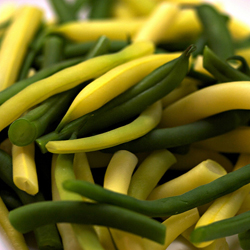 A few weeks ago, we headed down to Los Angeles for a quick getaway. Ostensibly, the occasion was our seventh(!) wedding anniversary, but truthfully the real purpose of our trip was to eat at all the places we’d been adding to our ever-expanding “must-try” list.
A few weeks ago, we headed down to Los Angeles for a quick getaway. Ostensibly, the occasion was our seventh(!) wedding anniversary, but truthfully the real purpose of our trip was to eat at all the places we’d been adding to our ever-expanding “must-try” list.
At the very top of said list was Pizzeria Mozza, the newish joint venture from Mario Batali and Nancy Silverton. After hearing rave reviews from pretty much every newspaper, magazine, blog, and friend, we decided to schedule Mozza in a prime Friday-night slot, to make sure we were getting the A-team of cooks and servers.
I won’t bore you with the litany of every thing that went wrong that night — we’re over the tedious exercise of writing negative restaurant reviews — but here’s the short version: Unexciting food, abysmal service, and pacing so unbelievably rushed that we were back in our car just 29 minutes after our first (and only) glass of wine hit the table. Seriously.
But every cloud has a silver lining. And at Mozza, that lining took the form of a fabulous melange of slender haricots verts, sweet shallots, crunchy hazelnuts, and creamy whole-grain mustard dressing (which, ahem, arrived in place of the roasted-cauliflower dish we’d actually ordered). Amid a menu of fair-to-decent dishes, this small plate stood out, and we quickly realized that we could easily duplicate it at home. We combed through every Batali and Silverton cookbook we own, but found nothing similar. However, Googling “beans + mustard + vinegar + hazelnuts” led us to a likely recipe — not from either of the Mozza chefs, but from Chef Dan Barber of New York’s Blue Hill restaurants.
Although we’re still a few weeks away from finding slim haricots at our market, their larger cousins are already becoming plentiful. And though hazelnuts aren’t grown in the Bay Area, we have plenty of other local options. We opted for walnuts, but made them a little more decadent by rubbing off their skins after toasting them lightly in a pan. After that, the rest of the dish comes together in a matter of a whisk here, a blanch there. And when served with a quick-brined pork chop and the first new potatoes of the year — as we did, for our One Local Summer meal this week — it makes for a great summer side-dish.
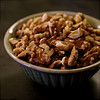

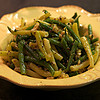
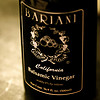
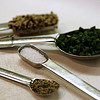
Summer Beans in Grainy Mustard Vinaigrette
— adapted from Dan Barber
1 T finely chopped shallots
2 T balsamic vinegar
12 oz trimmed green and yellow-wax beans (about 4 cups)
1/2 T whole grain mustard
1/4 cup good-quality extra-virgin olive oil
1 T chopped chives
1 T plus 1/4 tsp salt
1/4 tsp freshly ground pepper
2 T blanched nuts (we used walnuts) toasted, peeled if desired, and coarsely chopped
Soak shallots in balsamic vinegar in a small bowl for 30 minutes; set aside for later use.
Fill a saucepan with 2 quarts of water and 1T salt; bring to a boil. Meanwhile, fill a large bowl with water and ice.
When water comes to a boil, add beans and cook until just tender, about 3 minutes. Drain quickly and shock beans in the ice-water bowl. When fully chilled, drain beans well, pat dry, and set aside.
Stir mustard into balsamic-soaked shallots. Gradually whisk in olive oil until blended. (If you’d like a creamier dressing, buzz with a stick blender until well emulsified.) Add the chives, 1/4 teaspoon salt, and pepper; stir until combined.
Toss dressing with beans and nuts until evenly coated; serve immediately.
Farmers and food artisans who created the ingredients for this week’s meal: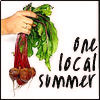 Marin Sun Farms
Marin Sun Farms, Point Reyes: Pork chop
Fox Barrel, Fairfax: Hard cider (for brine)
Eatwell Farm, Dixon: New potatoes
Dirty Girl Produce, Santa Cruz: Shallots
Bariani, Sacramento: Olive oil and balsamic vinegar
Dwelley Farms, Brentwood: Green and wax beans
Boccalone, Oakland: Whole-grain mustard
Glashoff, Fairfield: Walnuts
…and our own
homegrown chives and homemade chicken stock
locavore, One Local Summer, recipes, restaurants, SoCal
12 Comments »




Posted by Anita on 05.11.09 7:18 PM
 It’s hard to believe that in just two months — July 8 through 12 — we’ll be back in New Orleans for this year’s Tales of the Cocktail. Cameron and I are both participating in this year’s TalesBlog group, and {gulp} I’m moderating a Saturday-morning seminar called “Secrets of Cocktail Photography“.
It’s hard to believe that in just two months — July 8 through 12 — we’ll be back in New Orleans for this year’s Tales of the Cocktail. Cameron and I are both participating in this year’s TalesBlog group, and {gulp} I’m moderating a Saturday-morning seminar called “Secrets of Cocktail Photography“.
TalesBlog is already up and running with previews of many of the interesting sessions, tasting rooms, events, and meals that make Tales the must-do event for anyone who loves cocktails. The contributor list is pretty much a Who’s Who of top cocktail bloggers, so it’s worth adding to your feed-reader even if you’re not planning to attend.
In other Tales-related news, host venue Hotel Monteleone is celebrating the 60th anniversary of the Carousel Bar, and they’re celebrating with a contest open to all bloggers. Here’s the gist: From 1949 until sometime in the late 60s or 70s there was a drink on the Carousel Bar’s menu called the Monteleone Cocktail. Unfortunately, the hotel folks have no idea what the exact recipe or ingredients were.
Here’s where you come in: Submit a recipe for your best idea for the new official Monteleone Cocktail. Entries will be judged by VIPs at the Carousel anniversary celebration on May 21. There are no requirements on types of liquor or style of drink, but all entries must be posted on your blog and emailed to the sponsors no later than May 18. (Send your drink recipe, along with your name, address, and phone number, to athornton@hotelmonteleone.com.)
The winning entry will become the new official Monteleone Cocktail, and the winner will receive four free nights at Hotel Monteleone during Tales of the Cocktail 2009.
bar culture, drinks, New Orleans, Tales of the Cocktail, travel
5 Comments »




Posted by Anita on 02.22.09 8:54 PM
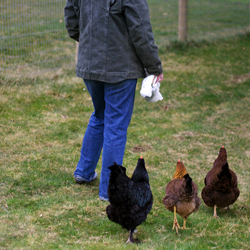 It’s such a treat to travel around the country (and the world), enjoying all sorts of things that we don’t get here in San Francisco, so we usually put our locavore ways on hiatus when we’re on the road. Occasionally, we’re able to enjoy the best of both worlds, either by visiting a restaurant where the chef sources his ingredients locally, or by shopping for local ingredients and cooking our own meal.
It’s such a treat to travel around the country (and the world), enjoying all sorts of things that we don’t get here in San Francisco, so we usually put our locavore ways on hiatus when we’re on the road. Occasionally, we’re able to enjoy the best of both worlds, either by visiting a restaurant where the chef sources his ingredients locally, or by shopping for local ingredients and cooking our own meal.
But during our Seattle trip over President’s Day weekend, we did one better: We wrangled an invitation up to the (Not So) Urban Hennery for dinner with Laura and her husband Mike.
Despite a persistent drizzle that followed us up I-5 from the city, we arrived in Arlington with just enough sunlight left for a quick farm tour. We put on our boots and headed out to visit the hens. As soon as they saw us (or, really, Laura… she’s definitely at the top of their pecking order!), the girls started up with such a symphony of cackles, chortles, and clucks that we couldn’t help but laugh. They know that the bag in Laura’s hand is full of kitchen scraps, and I suspect they have an idea that there’s cracked corn on offer, too.
As the light waned, we watched Jake and Sam play in the yard as the chickens devoured the goodies Laura had brought them. (Talk about sustainability! Table scraps in, eggs out.) We talked about the plans for the rest of the acreage behind the house, admired Mike’s new fence, and then retreated into the warm kitchen for a snack of local cheeses and a basket of homemade crackers, along with some locally produced hard cider.
 We gathered around the table in the stylishly cozy dining room for an all-local — and pretty much all-homegrown — supper of home-farmed chicken (naturally!) grilled to golden perfection by Mike, along with local wines, pan-braised purple carrots, and a stunning salad of garden spinach topped with local hazelnuts and dried cranberries. It was all delicious, but my favorite part was an amazingly simple potato gratin that showcased Laura’s earthy home-grown potatoes.
We gathered around the table in the stylishly cozy dining room for an all-local — and pretty much all-homegrown — supper of home-farmed chicken (naturally!) grilled to golden perfection by Mike, along with local wines, pan-braised purple carrots, and a stunning salad of garden spinach topped with local hazelnuts and dried cranberries. It was all delicious, but my favorite part was an amazingly simple potato gratin that showcased Laura’s earthy home-grown potatoes.
The recipe — which Laura’s adapted over the years from Nigel Slater’s Appetite — calls for what the author rightly calls an “almost obscene quantity of cream”. Laura says she’s had relatives refuse to eat it after they watched her make it! But really, without any cheese or extra butter, it’s probably not much more decadent than the gratin that you likely already call your favorite. The recipe serves 6 at least, maybe 8 (unless they’re shameless potato gluttons like me).
Back home amid the rain and the beginnings of our spring-cleaning project, we decided to make a whole batch just for the two of us — they’re that spectacular. “They’re even better left over,” says Laura, “Especially if you warm them back up in the oven with a bit of foil over the top.”





Dreamy Potato Gratin
– adapted from Appetite
2 pounds potatoes (about 3 large)
1/2 medium onion (or a leek), sliced very thin
4 cloves garlic, minced
salt & pepper to taste
1 to 2 pints heavy cream, as needed*
Preheat the oven to 400°F.
Peel potatoes and slice thin (about 1/8-inch or 3mm). Toss with the sliced onion and minced garlic, and salt and pepper to taste. Layer the mixture in a well-buttered 9×9 pan and top with enough cream to come halfway up the top layer of potatoes but not submerge them completely. Sprinkle with a little more salt and pepper.
Put the baking pan on top of a rimmed cookie sheet as insurance against a huge oven mess in case of bubbling over. Bake in the preheated oven, pressing the potatoes down into the liquid when the cream starts to expand. At the 20-minute mark, press the potatoes into the cream again and reduce the oven temperature to 350°F.
When the gratin starts to color and smell good — about the hour mark — check the potatoes for doneness by inserting a knife into the center. Continue to bake until the potatoes are no longer at all crunchy but not yet mushy. If the top begins to get too brown, move the gratin to a lower rack and turn the temperature down to 300°F. When done, remove from the oven and let sit for a few minutes to allow the gratin to set.
* The quantity of cream needed will depend on how close you’re able to get your potatoes to the 2-pound mark, how much potato you lose to peeling and trimming, and the exact dimensions of your pan. Laura’s dish is closer to 10×10 and fairly deep, so she uses 2 whole pints. 1 pint was perfect in my standard 2-quart 9×9 pan.
Dark Days challenge, locavore, other blogs, recipes, Seattle
9 Comments »




Posted by Anita on 02.06.09 9:36 PM
 I know that it’s been awfully quiet around these parts for a while, but whirlwind trips to New York City will severely cut into your blogging time. The lovely folks at NOTCOT and Liqurious sent me on a hybrid photography/writing assignment to cover the launch of Rosangel, a new hibiscus-infused tequila from Gran Centenario.
I know that it’s been awfully quiet around these parts for a while, but whirlwind trips to New York City will severely cut into your blogging time. The lovely folks at NOTCOT and Liqurious sent me on a hybrid photography/writing assignment to cover the launch of Rosangel, a new hibiscus-infused tequila from Gran Centenario.
You can probably guess that I don’t have a lot of personal affection for flavored spirits, but my better judgment prevailed: As freelance gigs go, getting to visit New York for a long weekend sure beats the hell out of just about anything else.
I fretted about how to make a rose-pink tequila sound credible to our cocktailian friends. But in all honesty, from what I was able to taste at the event, Rosangel has all the hallmarks of a quality product. It uses Gran Centenario reposado as its base, it’s aged for an additional 2 months in port casks to give it complexity and a rosy glow, and then it’s infused with hibiscus blossoms, not doctored with artificial flavors. I’m anxiously awaiting the chance to get my hands on a bottle to play with; the retail launch is set for March.
What I didn’t know when I accepted the assignment was that one of the events would be held at Clover Club, the newish Brooklyn bar from Julie Reiner of Flatiron Lounge fame. And, better still, that I’d have a chance to watch Ms. Reiner and Paul Pacult lead a hands-on immersion training for eight tequila-loving bartenders flown in from all around the country. (I won’t steal my own thunder any more than I already have: You’ll have to check out the NOTCOT post for the full scoop.)
So anyway, apologies for the radio silence. At least you know I had a good excuse! I promise there’s another post coming soon, all about the 70-pound pig we roasted for Cameron’s big birthday.





(Oh man, I shot so many frames… picking just five representative photos for the filmstrip this time is impossible! Please click through to see the whole collection.)
bar culture, drinks, NYC, other blogs
6 Comments »




Posted by Anita on 01.19.09 10:38 PM
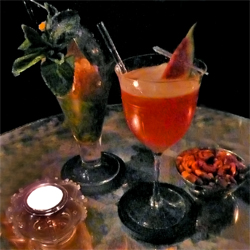 When you go to London, if you’re at all interested in the mixological arts, I recommend you bring an ample supply of cash, a large bottle of milk thistle, and a suitcase full of bubble wrap. Dear reader, they have so many wonders across the Pond that we only dream of Stateside.
When you go to London, if you’re at all interested in the mixological arts, I recommend you bring an ample supply of cash, a large bottle of milk thistle, and a suitcase full of bubble wrap. Dear reader, they have so many wonders across the Pond that we only dream of Stateside.
First among these treasures is a plethora of eye-poppingly gorgeous (not to say purse-poppingly pricey) cocktail establishments. The exchange rate is lately favourable to the American drinker, as much as can be possible. But a list of cocktails priced at £16, or £18, or even a heart-stopping £26 a sniff is bound to set even the hardiest of world travelers back on her heels. It was only the Christmas holidays and the attendant closure of many of the Capital’s top watering holes that saved us from coming home skint.
One of the key reasons for the allure of said establishments — apart from their five-star decor and their world-class staff — is the ability for a colonial to sample libations that simply never make it to our shores. Rare malts! Esoteric liqueurs! Cuban rums! The mind reels at the possibilities of the drinks that could be shaken, if only one had access to such wonders. (Happily, one does. Although London’s spirits emporia are small in number, they’re rich in merchandise, easily discovered, and more than happy to abuse your charge card in exchange for some very fragile cargo for the return flight.)
One of the best drinks we enjoyed while in London married both of these two alluring elements, the fantastically beautiful bar and the enticingly rare ingredient.
 Aided and abetted by another London treasure, Jay Hepburn — proprietor of the spectacular blog known as Oh, Gosh! — we spent an evening taxing the hospitality of not one but two of London’s luxury-hotel lounges, the Bar at The Dorchester and Connaught Bar. Though our night at The Dorchester will forever remain a highlight of our London trip (due in no small part to the extraordinary welcome we received from our gregarious barman, Stefano, and his flawless drinks that kept us so enraptured that we missed the last train of the night!), the Connaught was a stunner.
Aided and abetted by another London treasure, Jay Hepburn — proprietor of the spectacular blog known as Oh, Gosh! — we spent an evening taxing the hospitality of not one but two of London’s luxury-hotel lounges, the Bar at The Dorchester and Connaught Bar. Though our night at The Dorchester will forever remain a highlight of our London trip (due in no small part to the extraordinary welcome we received from our gregarious barman, Stefano, and his flawless drinks that kept us so enraptured that we missed the last train of the night!), the Connaught was a stunner.
It’s an opulent space, somehow embodying both splendid beauty and undeniably comfort. The staff are impeccable, gracious to a fault, and thoughtful to the utmost detail, from the first greeting to the last farewell. We were welcomed with a complimentary sip to enjoy while we perused the menu, then presented with a sheaf of recipes for the drinks we’d enjoyed at the end of the evening — an enchanting gesture that I hope will be the start of an international trend.
Though we savored many wonderful drinks that night, the final nod must go to the very first I tasted at Connaught Bar: a complex, spicy bit of exotica known as the French Sin. It’s not a simple drink to make, requiring a flavoured sugar, a barely seasonal fruit, a rare vermouth, and a carbonated tea infusion. Nevertheless, the rewards, as they say, are in the glass.
The French Sin also makes a perfect candidate for this month’s Mixology Monday: New Horizons, hosted by the anonymous Scribe of A Mixed Dram. Encouraged to sample a new spirit (amber vermouth, check!) or a new technique (carbonating tea — check again!), the French Sin covers all the bases. But if for some reason, you can’t be bothered to fizz your own tea, procure a bottle of rare vermouth, or infuse vanilla beans into sugar, never fear: The gentlemen of the Connaught Bar will be happy to oblige.



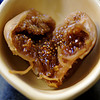

French Sin
– Connaught Bar, London
1/2 fresh fig
1/2T to 1T vanilla sugar
1-1/2 oz Armagnac
1/2 oz amber vermouth
3/4 oz lemon juice
3/4 oz rooibos spiced soda water
Muddle the fig in the shaker with the vanilla sugar, then add the rest of the ingredients — other than the spiced soda water — and shake with ice. Double-strain into a small goblet and top with rooibos spiced soda water, and stir briefly to combine. Garnish with a quarter of a fig.
—
If figs are out of season, look for the freshest dried figs available. Rehydrate them in a small amount of hot (not boiling) water until soft enough to muddle. For garnish, use a lemon twist or a yellow flower, reminiscent of a vanilla orchid.
Vanilla sugar can be purchased in gourmet shops or spice stores — Penzey’s makes a nice one, as does Nielsen-Massey. To make your own, grind a half of a dry vanilla bean in a spice grinder or coffee grinder with a small amount of granulated sugar. Add this vanilla powder to 1 cup sugar and let sit at least 24 hours (and preferably up to a week) before using. In this recipe, you can use the sugar as-is, since you’ll be straining the shaken mixture, but in baked goods or as a general sweetener, use a fine sieve to remove the larger pieces of vanilla pod after the infusing is complete.
To make the rooibos spiced soda, steep 4 tsp spiced rooibos tea (or 1T pure rooibos tea plus a few cardamom pods, whole peppercorns, and cloves) in a quart of hot water for 5 minutes. Strain, chill thoroughly, and charge in a soda siphon.
bar culture, coffee & tea, London, Mixology Monday, recipes
8 Comments »




Posted by Anita on 01.03.09 7:53 PM
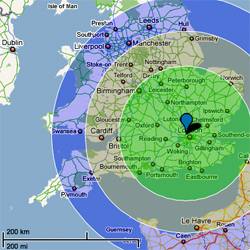 When you live on an island that’s a mere 300 miles wide, local food is a relative thing. In the map to the left, the blue pin shows the location of our London flat. The green circle — which touches the Normandy coast of France — shows a 100-mile radius; yellow encompasses 150 miles, and blue — which grazes Paris! — illustrates the 200-mile radius that many wintertime eat-local challenges allow.
When you live on an island that’s a mere 300 miles wide, local food is a relative thing. In the map to the left, the blue pin shows the location of our London flat. The green circle — which touches the Normandy coast of France — shows a 100-mile radius; yellow encompasses 150 miles, and blue — which grazes Paris! — illustrates the 200-mile radius that many wintertime eat-local challenges allow.
Looks like it would be easy to eat local, doesn’t it? I’m sure with a little practice and a bit of hunting, it definitely could be. But when you’re on holiday and have no understanding of where cities, counties, and postcodes are situated within Britain, it’s definitely a challenge. And when we discovered that most of London’s farmers markets run on a reduced schedule and roster for the run-up to Christmas, we thought we might have to call a vacation hiatus on making our weekly Dark Days meal from all-local ingredients.
Our biggest shock came on an afternoon trip to the world-famous Borough Market, the place we assumed would be the highlight of our shopping excursions. But although it’s still a feast for the eyes, it’s definitely taken on a more-corporate feeling since our last visit. And despite the wealth of delectables on offer, we found it nearly impossible to unearth items grown or produced local to London. One very pleasant exception: Mrs King’s gorgeous raised-crust pork pies are made in the appellation-controlled region of Melton Mowbray, about 90 miles from London.
Most of the bread we found, at Borough and in shops, was baked either on the outskirts of London, or in nearby Oxfordshire. Once we got a little basic geography under our belts, finding local ales and ciders was easy-peasy, even in the big supermarkets. And many well-regarded packaged products — preserves, pickles, mustards, crackers, cookies, and so forth — are made in Britain, if not within southern England per se.
 If you’re willing to leave the foodie haunts and supermarkets behind, the news gets better. FARMA-certified London Farmers’ Markets have some of the most thorough guidelines I’ve ever seen, touching on everything from permissible ingredients in artisan goods to animal welfare to to maximum distances traveled: Everything sold must be “raised, grown, produced, gathered, caught, or baked within 100 miles of the M25”, London’s exterior beltway. Even on a very slow week at the Marylebone Farmers Market, we were able to cobble together a full meal: Sausages (produced on Food Fore Thought‘s East Sussex farm, using their own-raised pork), Brussels sprouts, and potatoes, which we served with a store-bought bottle of real ale from Hook Norton in Oxfordshire, 81 miles from London.
If you’re willing to leave the foodie haunts and supermarkets behind, the news gets better. FARMA-certified London Farmers’ Markets have some of the most thorough guidelines I’ve ever seen, touching on everything from permissible ingredients in artisan goods to animal welfare to to maximum distances traveled: Everything sold must be “raised, grown, produced, gathered, caught, or baked within 100 miles of the M25”, London’s exterior beltway. Even on a very slow week at the Marylebone Farmers Market, we were able to cobble together a full meal: Sausages (produced on Food Fore Thought‘s East Sussex farm, using their own-raised pork), Brussels sprouts, and potatoes, which we served with a store-bought bottle of real ale from Hook Norton in Oxfordshire, 81 miles from London.
And in the world beyond all-local, the news is better still. Even in mainstream supermarkets like Waitrose and Sainsbury’s, it’s easy to find cage-free eggs and pastured chickens; a solid majority of carton eggs sold in the UK are cage-free. Thanks to many campaigns by celebrity chefs like Jamie Oliver and Hugh Fearnley-Whittingstall, Britons are by now far more aware of the intrinsic cruelty of the battery hen system than the average consumer here at home. And in England, organic certification — the kind you see stamped on supermarket chickens — means more. It’s not just a simple matter of feeding Chinese organic soy to your animals; the Soil Association (Britain’s main certification agency) guidelines call not just for a cage-free environment, but true “freedom to range”.
Lest you think this means a giant warehouse with a tiny door to a barren yard, the guidelines actually stipulate that birds may not even be permanently housed, and that their forage must be “well-covered with suitable vegetation”. And SA-certified poultry isn’t just something you’ll find in posh shops: Even on the New Year’s Day bank holiday, we had no trouble finding SA-certified organic chicken parts in a ‘Sainsbury Local’, a neighborhood grocery the size of a 7-11. We couldn’t find any evidence that this meat was local to us, but it was labeled “product of Britain”, as were many meat packages we saw and bought.
Despite handicaps of seasonality and familiarity, I feel like we were able to do quite well, rather easily. It’s hard to ignore the feeling that it feels easier to put together an ethical and reasonably environmentally sensitive meal in London than in nearly any other large city we’ve visited.





Dark Days challenge, farmers markets, locavore, London
4 Comments »




Posted by Anita on 12.28.08 6:34 AM
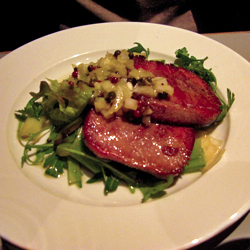 Even in the foodie heaven that is San Francisco, there’s no place like Konstam at the Prince Albert. A Victorian pub that’s been converted to a high-design jewelbox restaurant — it would take an entire paragraph just to explain the chandeliers-slash-draperies — Konstam toes the eat-local line with none of the obfuscation inherent in the standard “….whenever possible” disclaimer of Bay Area menus.
Even in the foodie heaven that is San Francisco, there’s no place like Konstam at the Prince Albert. A Victorian pub that’s been converted to a high-design jewelbox restaurant — it would take an entire paragraph just to explain the chandeliers-slash-draperies — Konstam toes the eat-local line with none of the obfuscation inherent in the standard “….whenever possible” disclaimer of Bay Area menus.
Even more impressively, Konstam’s sourcing radius is dramatically smaller than the usual 100-mile American definition: 85% of the kitchen’s ingredients, including flour and protein, come from the area covered by the London Underground and/or bounded by the M25 beltway, depending on where you’re reading. Either way, we’re talking about more or less 25 miles from central London.
One more thing: It seems that the idea to source ingredients locally was written into the restaurant’s plan before Chef Oliver Rowe really knew it was possible — but after a television deal had been signed. As a result, his tiny temple to seasonal and local food was well-known to British foodies even before the first meal was served. A two-week BBC miniseries called The Urban Chef documented the trials and tribulations of opening Konstam and finding suppliers. Watching video of Chef Rowe scouring the outer reaches of London feels like nothing so much as a giant, £300,000 dare… with the entire country watching each night on the telly.
 But enough about the schtick: How’s the food? Rowe wisely chose Northern and Central Europe as his inspiration, so even in the dead of an English winter, there’s sense to be made of the menu. A bowl of celeriac and apple soup came scattered with abundant hazelnuts, chunks of blue cheese, and a sprinkling of dill; the portion was far too large for such a dense porridge, but the flavors were lovely. Cameron enjoyed a starter of grilled Sevenoaks ox tongue, perfectly buttery-soft but meaty, garnished with a piquant pickled peppercorn relish atop a slick leek salad. It’s hard to choose which of our mains was the winner: Cameron chose perfectly charcoal-grilled leg of mutton, served with intensely vegetal chard and comforting colcannon. My own moan-inducing roast pork belly — complete with scored crispy crackling — came with both picture-perfect roast potatoes and a too-sweet cabbage compote.
But enough about the schtick: How’s the food? Rowe wisely chose Northern and Central Europe as his inspiration, so even in the dead of an English winter, there’s sense to be made of the menu. A bowl of celeriac and apple soup came scattered with abundant hazelnuts, chunks of blue cheese, and a sprinkling of dill; the portion was far too large for such a dense porridge, but the flavors were lovely. Cameron enjoyed a starter of grilled Sevenoaks ox tongue, perfectly buttery-soft but meaty, garnished with a piquant pickled peppercorn relish atop a slick leek salad. It’s hard to choose which of our mains was the winner: Cameron chose perfectly charcoal-grilled leg of mutton, served with intensely vegetal chard and comforting colcannon. My own moan-inducing roast pork belly — complete with scored crispy crackling — came with both picture-perfect roast potatoes and a too-sweet cabbage compote.
Although the wine list includes mostly Continental offerings, you can opt for a well-balanced choice of English wines from Kent, about 60 miles away, or pick from a great assortment of local ciders and ales from artisanal producers. We sampled the Sauvignon Blanc-like Chapel Down white and the funky Burrow Hill extra-dry cider; neither required the expected “pretty nice… for a local product” caveats.
Dessert was a modern take on traditional Victoria sponge — cake layered with cream and preserves — drizzled with vanilla syrup. Simple and exceedingly sweet, it would have been lovely with the espresso we ordered, but never received. And on that note: London will never be known for its stellar table service, but Konstam’s was even a step below the usual indifference. We were so happy with our food that we weren’t too troubled, but I can conjur a mood where we would have been furious at all the many issues with poor pacing, forgotten items, and long stretches of time where waitstaff simply disappeared — no mean feat in a restaurant the size of a large living room.
You could imagine Konstam being a worthwhile destination simply as a curiosity, a stunt-piece of a restaurant built on a conceit that might age poorly. But even without its locavore angle, the food delivers without offering (or requiring) any apologies for its constraints.
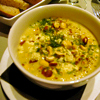

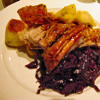


Konstam at the Prince Albert
2 Acton Street
London, WC1X 9NA
020 7833 5040
Dark Days challenge, locavore, London, restaurants
1 Comment »




Posted by Anita on 12.25.08 1:20 AM
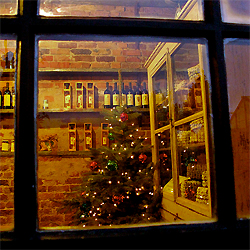 Happy Christmas, that is, from jolly old England! We’re having a blast on our vacation so far, eating lots of tasty food (fish & chips twice so far, both excellent), drinking pints of bitter in some gorgeous pubs, shopping at Borough Market, visiting with friends, and generally feeling very lucky to be in London at Christmas.
Happy Christmas, that is, from jolly old England! We’re having a blast on our vacation so far, eating lots of tasty food (fish & chips twice so far, both excellent), drinking pints of bitter in some gorgeous pubs, shopping at Borough Market, visiting with friends, and generally feeling very lucky to be in London at Christmas.
Speaking of luck: Don’t forget that today is the last day to bid on Menu For Hope raffle prizes. (Edited to add: The deadline’s been extended to 12/31!) If you have your heart set on winning our Ferry Plaza gourmet gift basket, the odds are still very promising. Be sure to check out Pim’s page for updates and new prizes that have been added along the way. There’s some good stuff in there that I’m sure someone on your last-minute present list would love to have a chance to win.
May your days be merry and bright!
holidays & occasions, London, Menu for Hope
3 Comments »




 Hungry Mother always seemed like the kind of place we’d enjoy: local and sustainable sourcing, Southern-inspired food, and a great cocktail list. It’s been on our short list of places to try for years, and on a recent trip to Boston, we finally made it there.
Hungry Mother always seemed like the kind of place we’d enjoy: local and sustainable sourcing, Southern-inspired food, and a great cocktail list. It’s been on our short list of places to try for years, and on a recent trip to Boston, we finally made it there.






















 It’s hard to believe that in just two months — July 8 through 12 — we’ll be back in New Orleans for this year’s
It’s hard to believe that in just two months — July 8 through 12 — we’ll be back in New Orleans for this year’s 































